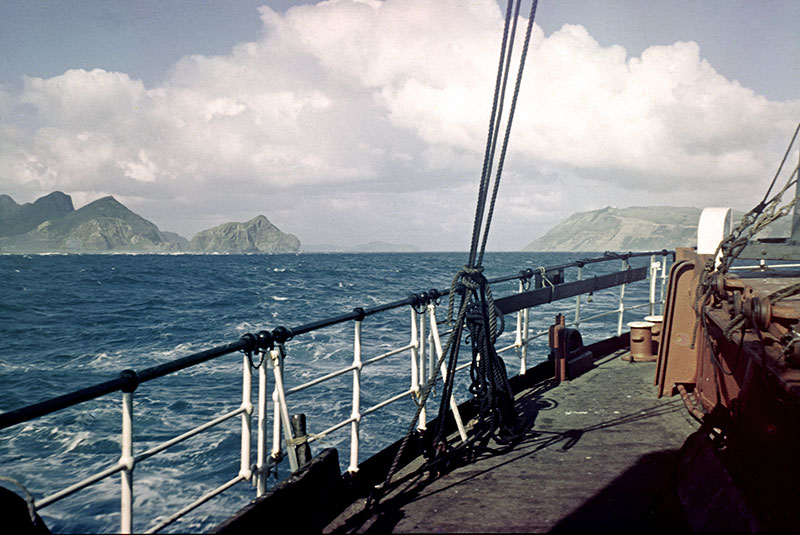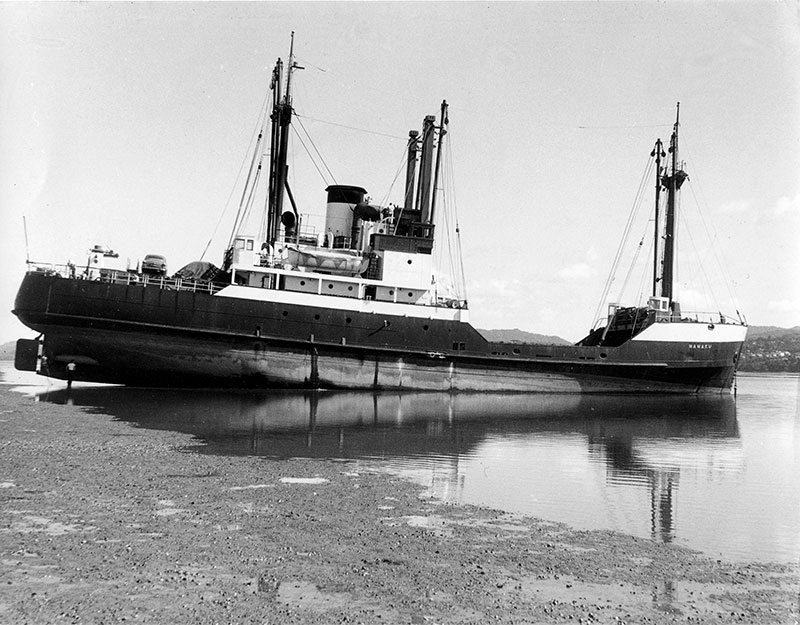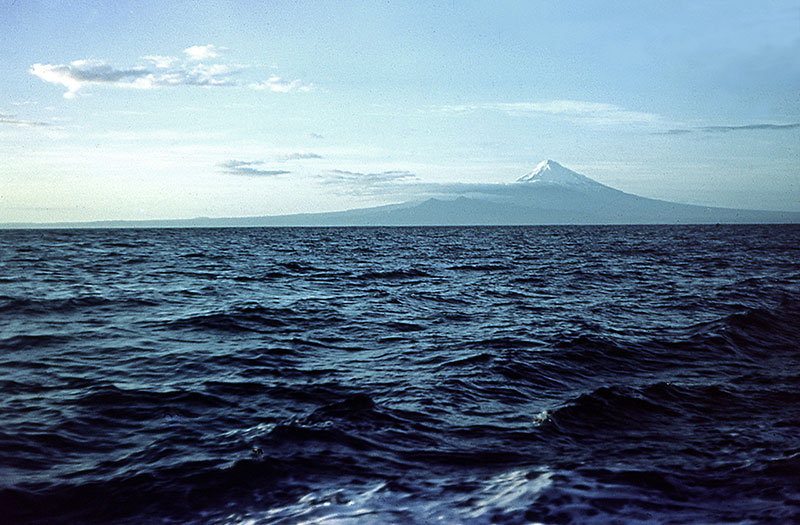Memories of the Mamaku
I worked as a deckhand on the Anchor Shipping and Foundry Company’s coaster Mamaku from 1955 to 1957, and during those years I took many photos of the ship and places she visited. Here are some notes to accompany those photos. The twin screw M. V.
I worked as a deckhand on the Anchor Shipping and Foundry Company’s coaster Mamaku from 1955 to 1957, and during those years I took many photos of the ship and places she visited. Here are some notes to accompany those photos.
The twin screw M.V. Mamaku was built for the Anchor Company by Henry Robb Ltd., Leith, and launched on 28 July 1949. The vessel left Middlesborough on 20 October that year with a cargo of 300 tons of coke for Auckland, where she arrived on 23 December, having travelled via Gibraltar, Port Said, Aden, Colombo and Australia. She reached Nelson, her home port, on 9 January 1950.
The Mamaku carried 670 tons of cargo on a mean draught of 11ft 6in. Her two holds had a total capacity of 40,000 cubic feet. Two British Polar diesel engines each of 375 b.h.p. gave her a service speed of 10 knots. Externally, the Mamaku somewhat resembled the Puriri, a larger vessel built for the Anchor Company a year earlier; but unlike Puriri, the Mamaku had no after deckhouse and her main mast was set on the midships superstructure. In fact, she bore a closer resemblance to the original pre-war Puriri (which was sunk off Bream Head in 1941 by a German mine), having a similar design and dimensions and exactly the same internal volume (927 gross tons).
The Mamaku was a tough little ship, like most of the other coasters designed for New Zealand waters. Her short hull and shallow draught enabled her to negotiate the small tidal harbours in Tasman Bay. In fact, she had been specifically designed to swing safely when berthing at Motueka, a port she visited frequently. There was nothing fancy about the Mamaku, but with her raked stem, raised forecastle and classic wooden bridge structure, she was a handsome vessel, stoutly built and well equipped to cope with New Zealand maritime weather and the dangerous sandbars outside Greymouth, Westport and the Manukau Heads. She was regarded by those who sailed in her as ‘a good sea-boat’, meaning she was a vessel that behaves well on the open sea in bad weather. She was responsive to the helm even in heavy seas, and did not pitch or roll unduly or ship a lot of water.
The Mamaku was fitted with the latest MacGregor ‘single-pull’ folding steel hatch covers, which could be opened or closed quickly by a single wire pulled from an electric winch. These were much more efficient than the cumbersome wooden hatches, tarpaulins and battening-down fittings used formerly. Steel hatch covers made a substantial contribution to the safety of a vessel in stormy weather, and the ‘single pull’ mechanism sped up cargo handling. The after hatchway on the Mamaku had four sections which could be opened or closed in 40 seconds. The much longer forward hatchway had seven sections, three stowed forward and four aft, and opening took about 60 seconds.
The ship was a real workhorse. Sometimes she was used to take coal from the West Coast to ports in the North Island. More often she was employed in carrying general cargo between Onehunga, Nelson and Wellington, all sorts of goods – motor vehicles and machinery, timber and other building materials, agricultural fertilizer, bales of wool, frozen meat and fish, fresh fruit and vegetables, and household appliances.
The tiny port of Mapua did not have any permanent wharf workers, and during the apple season the labour used to load cases of fruit was provided by local orchardists, who had a personal interest in getting their produce away to market quickly and in good condition. The deck crew manned the winches and supervised the stowing of the traditional white pine boxes containing the precious fruit. There were summer evenings at Mapua wharf when everyone, fruit growers and seamen, worked together frantically till midnight to finish loading the ship and enable her to catch the tide. I remember more than one such occasion when, dog-tired and sweaty after a long hot evening driving a winch, I was rostered on the graveyard watch - midnight to 4 am – and so was obliged to stay awake and alert enough to steer the ship when she put to sea.
At this time I was still a teenager, with the lowly rating of Ordinary Seaman – just one step up from a deckboy. I had a lot to learn, but the Mamaku was an ideal learning environment for an aspiring young seafarer. Senior shipmates saw to it that I was thoroughly trained in all the elements of seamanship. My chief mentors and role models were two of the most competent and respected Able Seamen one might have the good fortune to work with - Duncan Stewart, the Mamaku’s bosun, and Jack Kidson – both Nelson men.
I have vivid memories of the Mamaku’s regular run between Nelson and Onehunga. From Nelson she used to sail northwards across the South Taranaki Bight to Cape Egmont, then turned north-northeast towards the Manukau Heads, the entrance to Manukau harbour. In good weather the trip from Nelson to the Port of Onehunga took a day and a half. In heavy seas the trip was longer and less pleasant. Crossing the treacherous Manukau bar was always a bit of an adventure, whatever the weather.
There were other small adventures. One wild and stormy night after we had crossed the bar into the Tasman Sea I was sent aloft to secure a loose block that was flapping about and banging against a derrick by the after mast. A tipsy shipmate had left the block dangling and unfastened when we clewed up the derricks before leaving Onehunga. I remember hanging on grimly to the rail at the top of the mast as the ship lurched violently in the gale and the mast swayed out over the raging sea. With a lot of effort, I managed to haul up the wayward block and lash it to the rail, before creeping back down the ladder to the safety of the deck.
On another occasion the Mamaku got stuck on a sandbank in Manukau Harbour for the best part of a day. When eventually we returned to Nelson my photos of the stranded vessel were published in the Nelson Evening Mail. After the ship sailed that evening I was summoned to the bridge and rebuked severely by an irate skipper. Apparently my photographic evidence contradicted the euphemistic report of the incident which he had delivered to Anchor Company officials earlier in the day. But I had committed no sackable or loggable offence and there was a whole shipful of other witnesses to the incident, so all the disgruntled Captain Paddy could do was make it clear that he regarded me as an impudent young smart-arse.
One of the highlights of the Nelson-Onehunga trip was rounding Cape Egmont (Taranaki). There was always the hope of obtaining a glimpse of the majestic mountain from which the cape derives its name. Sometimes Mount Egmont would be completely shrouded in cloud and there was nothing to see. At other times the upper slopes and even the summit of the mountain might be revealed through a break in the clouds. But in fine clear conditions the view from the sea was unhindered and spectacular. On frosty winter nights the snow-covered peak was plainly visible, shining in the moonlight like alabaster. Even on a dark moonless night it could be discerned looming dimly and eerily in the starlight.
But to me, Mount Egmont always looked best when viewed from well out at sea in the early morning. Standing on the windswept deck of the ship, gazing at the mountain in the pale grey light of dawn, I felt that a deckhand’s job on the Mamaku was the finest job in the world.
2014. Updated June 2020
Story by: Ben Gibbs
Further Sources
Books
- Allan, R.M. (1954) The history of Port Nelson Wellington, N.Z. : Whitcombe & Tombs
http://www.worldcat.org/oclc/12565986 - Kirk, A. A., & Cannington, S. (1967). Anchor ships and Anchor men: The history of the Anchor Shipping & Foundry Company Ltd. Wellington: Reed
https://www.worldcat.org/title/anchor-ships-and-anchor-men-the-history-of-the-anchor-shipping-foundry-company-ltd/oclc/461485 - Moore, B. (1990) Shaping up and shipping out: the last years of the Nelson Harbour Board. Nelson, N. Z. : Published by Port Nelson Ltd. under contract to the Board
http://www.worldcat.org/oclc/84750140 - Neale, J. (1986). The Nelson Police: the story of the Nelson police district 1841-1986, Nelson [N.Z.] : New Zealand Police, Nelson District.
http://www.worldcat.org/oclc/37360879 - Nelson Harbour Board (1980) Port Nelson: the centre of New Zealand. Nelson, N.Z. : Nelson Harbour Board
http://www.worldcat.org/oclc/156307419 - Parr, W.H. (1979) Port Nelson - Gateway to the sea. Nelson, NZ : Nelson Harbour Board
http://www.worldcat.org/oclc/154321043
Websites
- Anchor Shipping and Foundry. Retrieved from New Zealand coastal shipping, 1 April 2014:
http://www.nzcoastalshipping.com/anchor.html - The Mamaku. NZ Ship and Marine Society. Retrieved July 2020:
https://nzshipmarine.com/nodes/view/308


